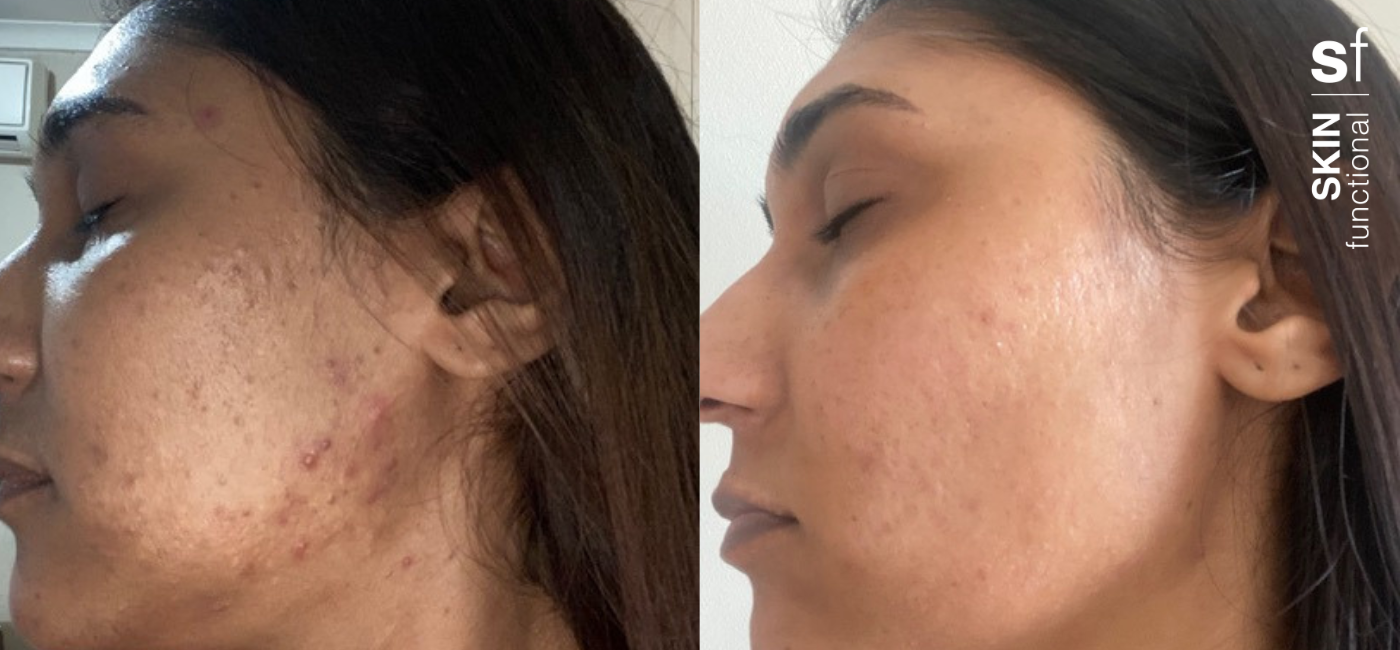
FREE SHIPPING FOR ORDERS OVER R500 WITHIN SOUTH AFRICA
Free shipping for orders over R500
FREE SHIPPING FOR ORDERS OVER R500 WITHIN SOUTH AFRICA
Free shipping for orders over R500

We have all heard that we need to exfoliate our skin, but do we know why? Or how? Or even how often? Dermatologists recommend a well-balanced microbiome being critical to the overall health of your skin. In this article SKIN functional, a skincare brand premised on sharing honourable SKINtelligence™ and providing products that have reproducible results™ with optimal concentrations™, will aim to explain what your microbiome is and how this relates to exfoliating as well as essentials acids in exfoliation and how to use them. All your questions answered below.
What is the microbiome?
Dr Lauren Knight, a board-certified dermatologist and advisor to SKIN functional explained that: “Your microbiome is essentially an ecosystem of good bacteria, viruses and fungi which live on the surface of your skin and is responsible for keeping your barrier functioning properly. When the microbiome is disrupted, there may be an overgrowth of specific organisms leaving your ecosystem unbalanced which can contribute to the development of skin conditions like eczema, acne and rosacea.”
Unfortunately, environmental stressors and pollution, diet and lifestyle, genes, and exposure to UV rays can all mess with your microbiome’s delicate equilibrium. However, you do have control over one of the main culprits that cause this imbalance – which is the way you exfoliate.
“Over washing, scrubbing, or exfoliating can disrupt the outer skin layer and create an inhospitable environment for microorganisms, which can disrupt the balance of the microbiome promoting inflammation,” added Dr Knight.
Now, that we know what over-exfoliation can do to the skin, let’s discuss its benefits:
“Exfoliation can help to improve our skin’s appearance. Our skin undergoes a natural process of cell turnover with the skin cycling every 4-6 weeks. Simply put, the cells start in the lowest layer of the epidermis and move through to the stratum corneum (top most layer) and are eventually shed. As we age this process slows down, resulting in our skin appearing dull and lack lustre, flaky and even more wrinkled. By exfoliating we are able to support the natural turnover of our skin allowing it to look brighter, less congested and even out pigmentation”, said Dr Knight.
Chemical versus physical exfoliation
Physical exfoliation is exactly as the name implies. The use of a product or substance that physically remove the cells. For example: this would be scrubbing brushes or cloths, or products that contain exfoliating beads. The danger of these is that these formulations are often quite abrasive and while you are removing the so called ‘dead skin’ you can over exfloliate in some areas or actually risk causing little breaks in the skin damaging the barrier and causing inflammation and sensitivity.
Dr Knight added: “That is why we as dermatologists prefer chemical exfoliants. Chemical exfoliants are compounds which exfoliate the skin through their chemical interaction with the components in the skin. They snip the bind between the cells causing them to be shed. One of the benefits of chemical exfoliants is controlled penetration and even coverage of the exfoliant. They are less abrasive to the barrier and in addition have benefits in terms of collagen stimulation and humectant properties which help to plump up the skin.”
Lastly, acids. AHA, BHA and PHA’s – what are they and how to use them
AHAs (Alpha Hydroxy Acids) includes glycolic acid, lactic acid and mandelic acid. These are your brightening acids. They exfoliate while stimulating collagen production and have humectant properties to plump up the skin. These would be your go to for dull, lack lustre skin or skin with uneven pigmentation.
BHAs work well in lipid rich environments. Salicylic acid is the best example of BHA. This acid penetrates the lipid rich environments typically found in the pilosebaceous unit relieving congestion and are ideally used in cases of acne.
PHAs or your Polyhydroxy Acids fall under the second generation of AHA’s. The most common ones being gluconolactone, galactosen and lactobionic acid. These ingredients have a larger molecular size when compared to AHAs and are thought to be more hydrating, great for plumping and reducing fine lines and wrinkles. PHAs are perfectly tolerable for dry and sensitive skin.
Fruit acids simply refers to your AHAs particularly glycolic acid, lactic acid, citric acid, malic and mandelic acid. They are referred to as fruit acids as some are derived from fruits. “I love fruit acids and BHA as options for exfoliation, obviously preferring chemical exfoliation over physical exfoliants. There are a number of skin benefits to be harnessed through their use and like your retinoids for example, you can try various formulations and concentrations to achieve the benefit you are hoping for in the formulation and strength you can tolerate,” added Dr Knight.
“Remember that you can definitely overdo it with exfoliation, even chemical exfoliation. While it may be advised to use at night this does not mean every night. Twice weekly is enough of a boost to your regimen.
The idea is to have a solid daily regimen to target your skin concerns while supporting your barrier and then your acids are nice to have as a booster. Remember that you don’t have to see a peel to know you are exfoliating, what you are going for is a glow, less dull and more even skin tone. Start low and go slow, Choose an acid that suits your skin concern. A healthy barrier is a glowing barrier not a flaking one,” concluded Dr Knight.
Watch the interview on SABC Morning Live with Dr Knight below;
We will give you the right amount of love!
From expert advice, specials and new products, be the first to know.
No spamming, we promise!






Click on the button below and choose 2 free gifts.
Hurry, while stocks last!